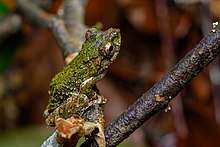Kurixalus bisacculus
Kurixalus bisacculus (common name: Taylor's tree frog and many others) is a species of frog in the family Rhacophoridae.[2] It is found in Southeast Asia and southern China. Because of confusion with other species (Kurixalus odontotarsus, Kurixalus verrucosus), the distribution is not well mapped but includes Thailand, Cambodia, Laos, Vietnam, and China. Populations from Hainan were formerly treated as a separate species, Rhacophorus hainanus (Hainan small treefrog), but molecular data suggest they are conspecific with Kurixalus bisacculus.[2][4]
| Kurixalus bisacculus | |
|---|---|
 | |
| Kurixalus bisacculus from Phu Kradueng National Park | |
| Scientific classification | |
| Kingdom: | Animalia |
| Phylum: | Chordata |
| Class: | Amphibia |
| Order: | Anura |
| Family: | Rhacophoridae |
| Genus: | Kurixalus |
| Species: | K. bisacculus |
| Binomial name | |
| Kurixalus bisacculus (Taylor, 1962) | |
| Synonyms[2] | |
|
Rhacophorus bisacculus Taylor, 1962[3] | |
Description
Males from Thailand measure 29–36 mm (1.1–1.4 in) in snout–vent length;[5] males from the Cardamon Mountains (Cambodia) measure 27–31 mm (1.1–1.2 in) in snout–vent length.[6] The female paratype measures 29 mm (1.1 in) in snout–vent length. The dorsum is brown with some darker markings; the venter is whitish to yellowish white. The tympanum is large.[3] The snout is pointed at tip and extends into a dermal projection, especially in females. All fingers have rudiments of webbing.[4] The toes are up to three-fourths webbed.[3] The chin, venter, and undersides of femurs are granulate. The undersides of the arms and tarsi have a row of tubercles, continuing onto the outer digits.[4]
Specimens from Hainan possess an internal vocal sac, whereas specimens from Thailand have an external one. In light of molecular evidence, this difference is considered to represent intraspecific variation.[4]
Habitat and conservation
Kurixalus bisacculus is found in vegetation or arboreally.[1][3][6] The IUCN assessment from 2004[1] predates the revision of the species boundaries of Kurixalus bisacculus and its closest relatives.[2][4] At the time, it was considered a common species that could be threatened by wildfires.[1]
Photos
 Kurixalus bisacculus (camouflage as moss) — Phu Kradueng National Park
Kurixalus bisacculus (camouflage as moss) — Phu Kradueng National Park.jpg) Kurixalus bisacculus (froglet) — Phu Kradueng National Park
Kurixalus bisacculus (froglet) — Phu Kradueng National Park
References
- van Dijk, Peter Paul; Swan, Steven; Chan-ard, Tanya; Dutta, Sushil; Ao, Meren & Bordoloi, Sabitry (2004). "Kurixalus bisacculus". IUCN Red List of Threatened Species. 2004: e.T58982A11853973. doi:10.2305/IUCN.UK.2004.RLTS.T58982A11853973.en.
- Frost, Darrel R. (2018). "Kurixalus bisacculus (Taylor, 1962)". Amphibian Species of the World: an Online Reference. Version 6.0. American Museum of Natural History. Retrieved 22 June 2018.
- Taylor, Edward H. (1962). "The amphibian fauna of Thailand". University of Kansas Science Bulletin. 43: 265–599. doi:10.5962/bhl.part.13347.
- Yu, Guohua; Zhang, Mingwang & Yang, Junxing (2010). "A species boundary within the Chinese Kurixalus odontotarsus species group (Anura: Rhacophoridae): New insights from molecular evidence". Molecular Phylogenetics and Evolution. 56 (3): 942–950. doi:10.1016/j.ympev.2010.05.008.
- Inger, Robert F.; Orlov, N. L. & Darevsky, I. S. (1999). "Frogs of Vietnam: A report on new collections". Fieldiana Zoology. New Series. 92: 1–46.
- Stuart, B. L. & Emmett, D. A. (2006). "A collection of amphibians and reptiles from the Cardomom Mountains, southwestern Cambodia". Fieldiana Zoology. New Series. 109: 1–27. doi:10.3158/0015-0754(2006)109[1:ACOAAR]2.0.CO;2.
